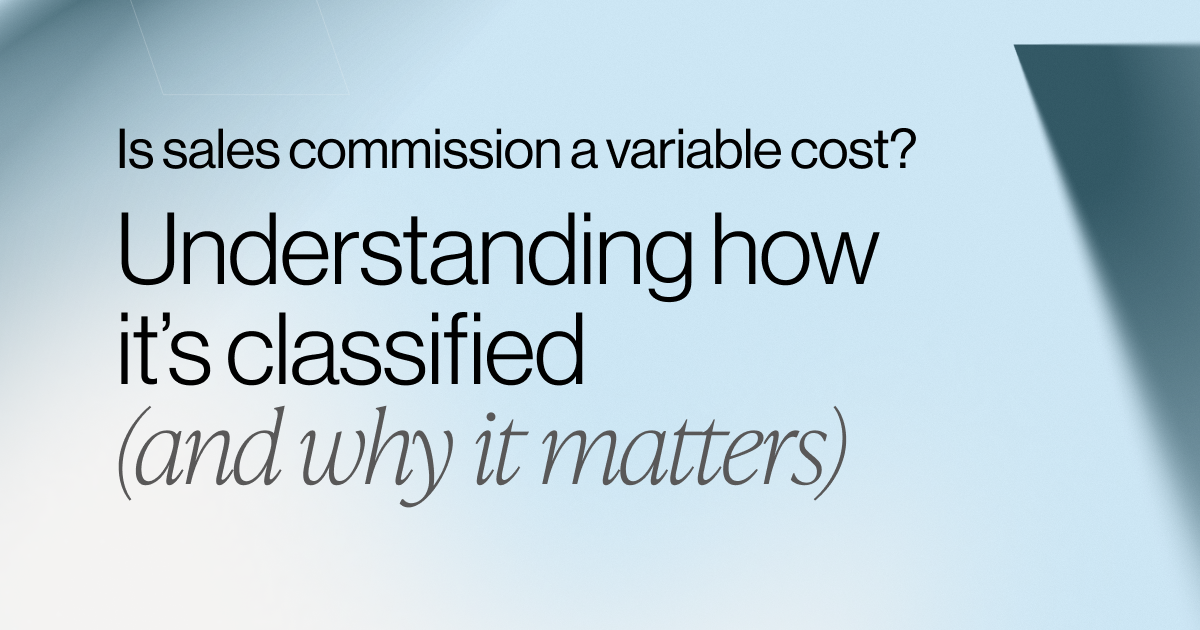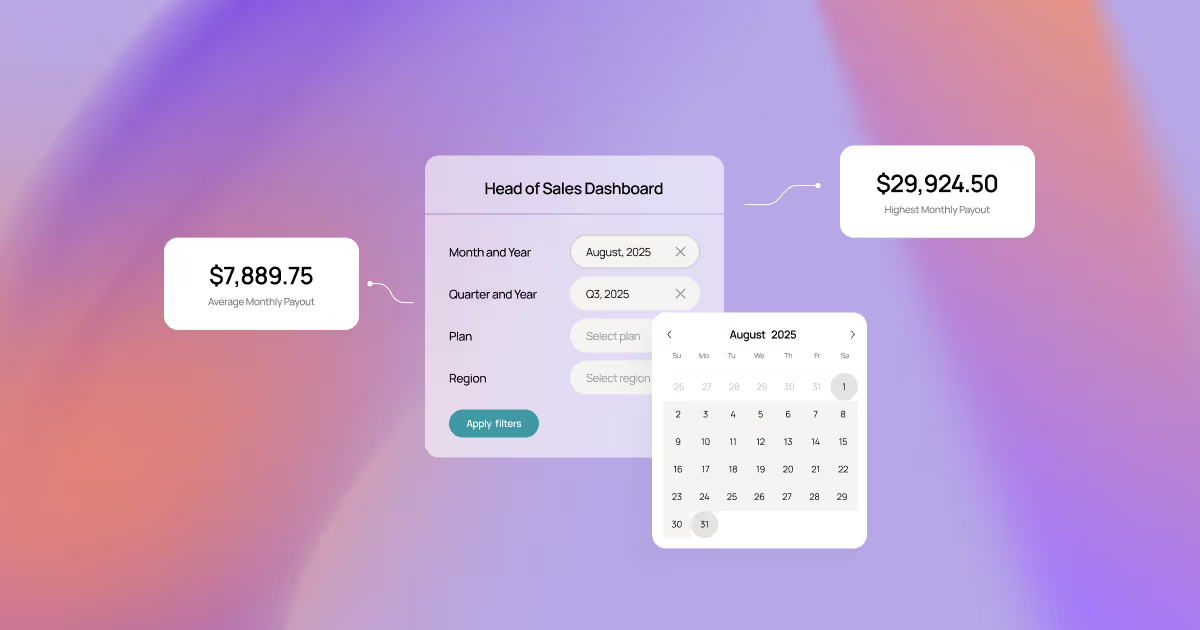Navigating Clawbacks for Sales Commission
If you’ve ever reviewed a sales rep’s commission agreement, you’ve likely encountered a “clawback” — a clause that allows companies to reclaim commissions from sales reps under certain conditions, like customer cancellations or non-payment.
Why do they exist? Typically, to protect the company from financial losses if the salesperson's actions (or the resulting sales) are fraudulent, illegal, or not in compliance with company policies. Clawbacks are especially common in regulated industries such as finance and healthcare, where non-compliant sales could result in major financial penalties.
Commission clawback provisions typically require that a salesperson return all or part of their commission if certain conditions are not met — below are some examples:
- If a customer cancels an order
- If a customer returns a product
- If a customer fails to pay an invoice for a product or service
- If a customer churns within a specific window of time
In some cases, commission clawback clauses are also implemented to adjust for deals with margins below target or even if the salesperson does not meet specific targets or violates company policies. Clawbacks can also apply to bonuses and performance-based incentives.
TL;DR: A commission clawback is a contractual clause that allows companies to reclaim commissions if conditions like customer cancellation, non-payment, or non-compliance occur.
What Triggers Sales Reps to Get Paid Commissions?
At first glance, you'd assume that most companies pay their sales reps upon customer contract close — and in looking at a sample of our customer base, this holds true.*
But some companies pay in multiple stages. For example, 76% pay at close, with subsets also paying at delivery (26%) or post-payment (10%).
*This finding is based on a small sample of our customer data and might be skewed toward the technology industry. We expect these results to shift as we broaden the data sample. Additionally, percentage totals may not equal 100% due to plans having multiple payout triggers (e.g., a sales plan that pays 50% when the deal closes and the remaining 50% when the customer pays).
How Are Negative Commission Balances Applied to Compensation Plans?
Clawbacks vary widely from company to company and plan to plan. According to a sample of our customer data, here are the four most common systematic approaches that we observe:
- Reduce quota credit the following period (35%): This approach is popular because it can be effective in certain contexts, such as when high-volume sales plans are in place and the “negative quota” evens out over time, and also, when the approach is relatively easy to implement.
- Recalculate the prior commission and true up (32%): Recalculating commissions after taking into account the net of the clawback tends to be a better fit for longer sales cycles or larger sale amounts, where a negative quota credit in the current period can have a demotivating impact. For example, a large clawback could ruin the current period and motivate the rep to slow other current-period sales into the next period to maximize the opportunity for above-quota multipliers.
- Claw back the specific amount paid on the deal (27%): Sales organizations may claw back the particular amount paid on a deal for several reasons. For example, if the organization discovers that a transaction was fraudulent or made under false pretenses — such as a salesperson misrepresenting the product or service being sold — it may attempt to recoup any payments made as a result of that sale. Another reason is to encourage salespeople to focus on building long-term customer relationships and customer satisfaction — e.g., if a customer cancels their contract shortly after closing, the organization may claw back some or all of the commission paid to the salesperson who closed the deal.
- Use management discretion (13%): This flexible approach allows the organization to consider each situation individually, considering the specifics involved. This can be especially useful when there isn't a clear-cut policy or contract clause that addresses the issue at hand — e.g., if a rep makes a sale but then engages in unethical behavior or behavior that damages the company's reputation, management may choose to withhold some or all of their commission payments as punishment.
Clawbacks differ depending on the company, plan, and context of the situation.
So, naturally, they’ve been the subject of much debate, with many questioning if they are a beneficial incentive for employees or simply an old-fashioned practice that is no longer necessary in today’s workforce.
What are the Benefits of Clawback Clauses?
Clawbacks can be an important protection for companies. Sure, salespeople need incentives and rewards, but paying out commissions on contracts that fail to convert to revenue or cash collected is not the winning model for a sustainable business. Clawbacks provide a level of protection for businesses, especially with the following advantages.
Discourages Unethical or Risky Sales Behavior
Clawback clauses protect companies by holding reps accountable for the long-term success of their deals. Without clawbacks, reps may prioritize closing deals at any cost — by overselling, misrepresenting product capabilities, or targeting unqualified customers — just to earn their commission. This behavior can lead to customer dissatisfaction, cancellations, or reputational damage for the company.
With clawbacks in place, organizations incentivize reps to focus on sustainable, high-quality sales that align with customer needs and business goals. For example, if commissions are subject to clawback for deals canceled within 90 days, reps are more likely to vet prospects thoroughly and avoid making promises they cannot deliver.
Protects Company Revenue From Short-Lived Deals
Clawback clauses help tie commissions to the longevity and success of deals rather than just their initial closure. In industries with recurring revenue models, such as SaaS or subscription services, clawbacks prevent the company from losing money on deals that fail shortly after signing.
For example, if a customer cancels a contract within the first three months of a one-year agreement, clawbacks allow the organization to recover commissions paid prematurely. This mechanism motivates reps to close deals with high retention potential rather than focusing solely on volume.
Clawbacks discourage reps from over-promising or selling to customers who may not fully benefit from the product or service. By aligning commission payouts with deal longevity, companies can safeguard their bottom line while encouraging reps to prioritize customer satisfaction and sustainable growth.
Aligns Sales Incentives With Long-Term Customer Success
Clawbacks also motivate sales reps to think about the future of their clients. Even if they’re not responsible for onboarding, reps can answer questions during the sales cycle and connect them to support services after the deal closes. By proactively addressing issues, customers can feel good about their purchase and stay on longer.
This is particularly valuable for subscription-based businesses. For instance, consider a company with a four-month clawback policy: if a customer cancels their subscription within four months of signing up, the sales rep must repay some or all of their commission. This policy motivates reps to target customers with long-term potential and ensure they set them up for success. It also discourages signing up poorly qualified or “bad fit” customers.
Mitigates Financial Risk and Reduces Overhead
Clawback clauses allow companies to recover funds from deals that fail due to cancellations, refunds, or other adverse events. Without clawbacks, organizations risk paying out commissions for deals that ultimately don’t generate revenue, creating unnecessary financial strain.
For example, if a large enterprise contract falls through shortly after signing, clawbacks ensure the company isn’t burdened with unrecoverable commission expenses. This also helps reduce overhead by aligning payouts more closely with actual revenue realization rather than projections.
When companies reclaim funds from short-lived deals, they can maintain healthier cash flow and reinvest resources into growth initiatives rather than covering losses.
What are the Risks of Clawback Clauses?
Clawbacks exist to protect the company and to ensure it stays financially stable, but they aren’t without their obstacles. Common issues from clawbacks include:
Damaging Sales Rep Morale and Trust
Clawback clauses, if not implemented thoughtfully, can negatively impact sales rep morale and trust. Reps may feel penalized for circumstances beyond their control, such as customer cancellations or refunds due to product issues or service failures. This perception can lead to resentment and disengagement, as reps may feel their hard work is undervalued.
If managers don’t communicate clawback policies transparently, reps may struggle to understand how clawbacks are calculated or why they are being enforced, further eroding faith in the organization. Over time, this can result in higher turnover rates and difficulty attracting top talent, as sales professionals often prefer companies with straightforward and rep-friendly compensation plans.
To reduce this risk, clearly communicate clawback terms, provide examples of how they work, and ensure fairness.
Administrative and Tracking Challenges
Clawback clauses can create administrative burdens for finance and HR teams, as they must track cancellations, refunds, and other triggers for clawbacks. Manual processes for recalculating commissions can be time-consuming and prone to human error. This problem is more common for companies with large sales teams or complex compensation structures.
For example, if a clawback is triggered months after a sale, finance teams must retroactively adjust payouts while ensuring compliance with company policies on paycheck withholding and labor laws that may limit how long companies can wait to deduct wages.
Tracking clawbacks across multiple deals or periods adds another layer of complexity, especially when tiered commissions or accelerators are involved. Without detailed rules in place for how every commission situation should be handled, these challenges can lead to disputes with sales reps over incorrect deductions or delayed adjustments.
You can mitigate risk by employing automated tools like CaptivateIQ that streamline tracking and enforcement by integrating clawback triggers directly into compensation workflows. This eliminates the need for manual data entry or managing multiple tools. For instance, Lendio was able to consolidate all commission payments across different schedules into one instance, significantly reducing reporting complexity and administrative overhead.
Causing Delays in Commission Payouts
Companies may delay commission payouts if they want to be cautious and avoid clawbacks altogether. For instance, some organizations may implement a “hold-and-release” model where commissions are withheld until a clawback window (30 or 90 days) has passed. While this protects cash flow, it can frustrate sales reps who rely on timely payouts as part of their income.
Delays also happen as a natural consequence of administrative inefficiencies. This happens more often when recalculating commissions after clawbacks are triggered, especially in manual systems that lack automation. These delays can harm rep motivation, as they may feel their earnings are being withheld without good reason.
To minimize the risk to rep motivation, clearly define payout timelines in compensation plans and leverage technology to automate adjustments quickly and accurately.
Legal Disputes if Terms are Unclear
Unclear or overly broad clawback clauses can expose companies to legal risks, such as civil suits from employees over enforceability. If the contract language does not explicitly define triggering events, repayment timelines, or calculation methods, sales reps may challenge the clause's legality. State labor laws add to the confusion.
Legal disputes drain resources and damage employee relations and company reputation, which may make it difficult to keep or attract good reps in the future.
Reduce risk by working closely with employment attorneys to draft clear and compliant clawback terms that align with federal and state laws.
Potential to Reduce Sales Aggressiveness
Clawbacks can unintentionally discourage sales reps from pursuing high-risk deals or aggressively chasing new business opportunities. If reps fear losing commissions due to potential cancellations or refunds down the line, they may prioritize safer deals over those with higher revenue potential but greater uncertainty. This cautious approach can curb creativity in deal-making while slowing overall revenue growth for the company.
Reps may also hesitate to upsell or cross-sell products if they believe these efforts could lead to clawbacks later due to customer dissatisfaction or product-related issues.
Finally, clawbacks tied to commissions on unpaid or delayed invoices can be a huge demotivator for sales reps—it is 100% out of their control! They may not see it as fair that they are getting penalized for a client's financial health.
To counteract this effect, incentivize reps to pursue quality deals without overly penalizing them for factors outside their control. For instance, if your historical data shows that deals closed within a specific timeframe or with certain customer profiles result in higher retention rates, give bonuses for deals within the timeframe.
This approach ensures reps prioritize quality leads and reduces the risk of clawbacks. Transparent communication about how clawbacks work (and when they won’t apply) can maintain a healthy level of sales aggressiveness while protecting company finances.
Examples of Sales Commission Clawbacks
Let’s say Kelly is commissioned on the annual recurring revenue (ARR) of closed won deals within a quota period. In Periods 1 and 2, the quota is $150,000 and $300,000, respectively. A base commission rate of 10% is paid on deal ARR through the attainment of period quota (Tier 1), and a 20% rate is paid for ARR amounts above the period quota (Tier 2).
Commission and clawback rules: Commissions are paid on bookings but are subject to a clawback for customer non-payment.
The following deals are closed in Periods 1 and 2. At the end of Period 2, the company determines that Deal A will not pay, thus triggering the clawback due to customer non-payment.

With that scenario in mind, let’s look at three different clawback methods.
Method #1: Exact Payout Amount
This method is the most common, thanks to its operational simplicity and intuitive nature for sales teams to follow.
Kelly earned a $5,000 commission for a sale that was not fulfilled, so she must then return the $5,000.

This method creates a relationship between the deal order and the clawback amount. As Kelly moves through attainment tiers during the quota period, the clawback amount is artificially tied to when in the period the deal closed.
For example, since Deal A is entirely within Tier 1, the clawback amount is 10% of the deal ARR. However, in the same period, Kelly earns accelerated commissions due to being above quota.
Alternatively, if Deal C were the deal that was clawed back, then the clawback amount would be $15,000 (20% of the deal ARR). Kelly’s payout at the end of Period 2 would be $16,000.
Why we like method #1: Most intuitive and straightforward for both employer and sales rep.
Method #2: Negative Quota Credit to Current Period
Method #2 protects the company from over-attainment by applying the clawback as a reduction of quota credit. The clawback is treated as a negative deal amount — as if it were a sale made with a negative revenue amount.
In the chart below, Deal A (Clawback) is added as a negative amount to the attainment in Period 2.

This method is operationally straightforward to automate in a calculation spreadsheet or system as most CRMs can provide debookings records in the exact negative amount as the original deal.
This negative deal amount can be referenced and considered in the current period’s commission calculation. Additionally, there is no need to reference historical payout periods, as you would in method #1 (or in method #3, described next).
A potentially negative impact is incentivizing the wrong behavior — motivating sales reps to defer deals to later periods if the attainment of Tier 2 commissions seems out of reach in Period 2.
How this could play out: Kelly anticipates Deal A to turnover in Period 2. This means Deal A effectively creates a period quota of $350,000 in closed ARR in order for Tier 2 commission rate attainment to be achieved. If Kelly thinks this is not attainable during Period 2, she will be incentivized to defer deals into Period 3. Both larger size and lower count of period deals contribute to this potential disincentive.
Given the operational simplicity of this method, it can be beneficial where there is high deal volume that can limit any disincentives to deal performance.
Why we like method #2: The need to match records to ensure the correct cancellation date is no longer necessary — simply add a new entry with a negative sale. Additionally, this method creates clearer commission statements.
Method #3: Negative Quota Credit to Past Period
This method balances fairness to the company and the salesperson by reducing quota attainment due to the clawback. However, unlike method #2, this one applies the clawback to the original period of the deal.

The adjustment to the quota attainment made in the preceding period reduces the over-attainment in Period 1 yet still protects the salesperson against the negative incentive of a negative quota event in the current period.
Operationally, it is very complicated for a spreadsheet to retroactively recalculate sales commissions each time there is a clawback. Moreover, further complexities arise from using this approach when a company is capitalizing its costs in compliance with ASC 606 due to the needed care it takes to ensure that clawbacks limit their impact on deal amounts previously recorded.
Why we like method #3: All the benefits of method #2 without incentivizing the wrong behavior (deferring sales to future periods).
To have or not to have commission clawbacks: The choice — and method — is yours.
As our favorite economists say, “Incentives matter.”
Each industry, company, and team will be unique. Consider the behavior you want to incentivize and use that as the key criterion.
Also, consider the realistic limitations the accounting team may face when given your organization's sales commission calculation tools.
Commission Clawback Best Practices
So, you’ve weighed the pros and cons and have decided clawbacks make sense for your team. Use the following best practices to enact them.
Clearly Define Clawback Conditions in Writing
A well-defined clawback policy starts with clear language that leaves no room for interpretation. This precision prevents disputes and ensures reps understand how their actions directly impact earnings.
First, specify exact triggers, such as customer cancellations, non-payment, contract breaches, or failure to meet performance milestones.
For example, clarify whether clawbacks apply to full cancellations only or partial refunds. You might consider reclaiming commissions proportional to the remaining portion of a canceled, multi-year contract.
Then, define exceptions, like waiving clawbacks if a customer terminates due to product defects or if the company restructures beyond the salesperson’s control. For instance, you might configure the system to trigger clawbacks only if cancellations occur within a 120-day window post-sale, with tiered reclaim percentages (e.g., 100% clawback in month 1, decreasing by 25% each subsequent month).
Align Clawback Policies With Your Overall Compensation Plan
Clawbacks should complement — not undermine — your compensation strategy. This integration ensures clawbacks reinforce your team’s motivation and trust in the comp plan.
For example, if reps earn accelerators for surpassing quotas, ensure clawbacks deduct reclaimed commissions from their original attainment tier, not their current performance tier. This prevents penalizing reps for future performance due to past deal reversals.
For subscription-based businesses, tie clawbacks to customer retention milestones. An example could be to have clawbacks expire after a 12-month renewal, so reps stay motivated to nurture sustainable deals rather than short-term wins.
If your sales compensation plan includes sales performance incentive funds (SPIFFs) or bonuses for specific products, apply clawbacks only to the variable commission tied to the lost deal, not base pay. You should also balance financial protection with fairness: cap clawbacks at 50% of a rep’s quarterly earnings or use sliding scales based on deal size.
Communicate Terms Transparently to Your Sales Team
Full disclosure and explanation are a must for maintaining trust and compliance with your sales reps. This proactive communication can keep disputes to a minimum and create more accountability in your teams.
To start, walk them through clawback scenarios during onboarding and quota reviews, and stay open to any questions that arise. Use real-world examples in everyday language, such as:
If a $100K annual contract cancels after three months, you’ll repay 75% of the commission earned ($100K × 10% × 9/12 = $7,500 clawback).
Then, consider compensation plan management tools like CaptivateIQ that offer a rep-facing dashboard. These tools show real-time impacts of cancellations on earnings and let reps see the potential outcome on their paycheck before they close deals.
Finally, document policies in easily accessible formats, such as annotated commission statements or a clawback FAQ linked to your CRM. If clawback terms change regularly, or you frequently add more reps to your team, host quarterly “clawback clinics” to address concerns and gather feedback. You can also incorporate clawback terms into deal approval checklists to ensure reps acknowledge risks upfront.
Include a Timeline for Clawback Enforcement
Define enforceable windows that balance accountability with practicality. This structure creates predictability while protecting company revenue. For example:
- Short-term products: 30–90 days for cancellations, common in retail or one-time purchases
- Subscription services: 6–12 months to account for onboarding and adoption periods
- Compliance violations: 24+ months for regulatory or ethical breaches with longer discovery timelines
For enterprise contracts with multi-year terms, consider staggered clawbacks such as reclaiming 100% if a client cancels in Year 1, 50% in Year 2, and 25% in Year 3.
You can also specify deadlines for finance teams to initiate clawbacks, such as within 14 days of a cancellation notice, to prevent retroactive claims from destabilizing reps’ earnings. For clarity, include language like:
Clawbacks will be applied to the next payroll cycle following cancellation notification and must be initiated within 30 days of the fiscal quarter’s close.
Use Contract Language That Holds Up Legally
In most cases, sales clawbacks are legal. However, the legality of a clawback depends on several factors, including contract terms and applicable laws and regulations. Two federal mandates to consider are the Sarbanes-Oxley Act (SOX) and Dodd-Frank Act, which require clawbacks for financial restatements or misconduct, even without executive wrongdoing.
Work with your legal team to see if the employment laws in your state allow clawbacks. For example, some state laws prohibit an employer from withholding commissions from a paycheck without the written consent of the employee.
Lawsuits can be very costly — you want to get clawbacks correct from the get-go. Look to the infamous $150M Oracle case for an expensive example of what can happen when clawbacks aren’t understood or even agreed to by the sales team.
Automate Tracking and Enforcement Through Your ICM System
Leverage an incentive compensation management (ICM) system to automate clawback tracking and enforcement. This reduces administrative burdens and ensures accuracy.
Why? Manually recalculating commissions or tracking clawback triggers is prone to errors and inefficiencies, especially as sales teams grow and compensation plans become more complex. An ICM tool streamlines this by automatically applying clawback rules based on predefined triggers, such as contract cancellations, refunds, or unmet performance metrics. They then recalculate the commissions in real time without needing intervention from the sales manager.
For example, systems like CaptivateIQ integrate with CRM platforms to pull in cancellation data directly, ensuring clawbacks are applied consistently without manual intervention.
Automation also enhances transparency by providing sales reps with detailed breakdowns of clawback adjustments via dashboards or reports. This visibility fosters trust, as reps can see the exact calculations behind deductions. These automated systems ensure policy compliance and reduce disputes by creating a documentation history that can later be used in case of an audit.
When you use an ICM to handle clawbacks, you remove the possibility of manual mistakes and save hours of time. Finance teams can then focus on strategic tasks while handling clawbacks efficiently and fairly.
Commission Clawbacks: The Choice is Yours
Ready to explore a smarter way to manage sales clawbacks and commissions? The hold-and-release approach lets sales reps receive their commissions immediately while protecting cash flow. CaptivateIQ supports this method through flexible automation features that simplify even the most complex commission plans.
Its SmartGrid™ technology processes millions of calculations in seconds and eliminates the manual effort that often leads to errors and disputes. CaptivateIQ also integrates seamlessly with CRM, ERP, and other systems to become a centralized platform for tracking clawbacks, quotas, and payouts.
CaptivateIQ doesn’t just simplify commission management — it transforms it into a strategic growth driver. Schedule a custom demo with our team to see this clawback solution technology in action.
Sales Commission Clawbacks FAQs
What Does Clawback Mean in Sales?
In sales, a clawback is a policy that allows a company to take back (or “claw back”) commissions already paid to a rep if certain conditions aren’t met. Common triggers include customer cancellations, non-payment, returns, or non-compliant sales. The goal is to protect company revenue and encourage reps to close sustainable, long-term deals.
What is an Example of a Clawback?
Suppose a rep earns a 10% commission on a $100,000 annual contract, receiving $10,000 upfront. If the customer cancels the contract after three months, the company may claw back 75% of the commission ($7,500) because only one quarter of the contract was fulfilled.
How is a Clawback Calculated?
Clawbacks are usually calculated based on the original commission earned, adjusted for how much of the contract was fulfilled. For example:
- Full cancellation → Repays 100% of commission.
- Partial cancellation → Repays commission proportional to the unused contract value.
- Policy-based clawback → Might follow a sliding scale (e.g., 100% clawback in the first month, 50% in month two, 25% in month three).
Companies may apply clawbacks as direct repayment, deductions from future commissions, or adjustments to quota credit.
How Do I Verify If A Clawback Calculation Is Correct?
To check that a clawback calculation is correct, review the clawback policy to ensure you understand the triggers and calculation method. Cross-check the deal data (e.g., value, commission rate, and cancellation details) with CRM records and confirm the adjustment aligns with the policy, whether retroactive or future-focused. Using tools like CaptivateIQ simplifies this process by automating calculations, integrating real-time data, and providing transparent breakdowns for accurate and auditable results.
How Long After A Sale Can A Company Implement A Clawback?
The timeframe for implementing a clawback depends on the company's policy and the nature of the sale. Typically, companies can enforce clawbacks within a specific period tied to customer cancellations or refunds, such as 30 days for short-term contracts or up to six months for longer agreements.
What Specific Contract Language Should I Look For Regarding Clawbacks?
Review contract language for triggering events, such as cancellations, refunds, or failure to meet performance metrics. Make sure each clause defines the timeframe for enforcement and the repayment process, including whether the clawback is retroactive or applies to future payments. You can also check for details on how compensation may be subject to clawback and the limits or caps on the amount recoverable to avoid confusion or disputes.
.svg)








